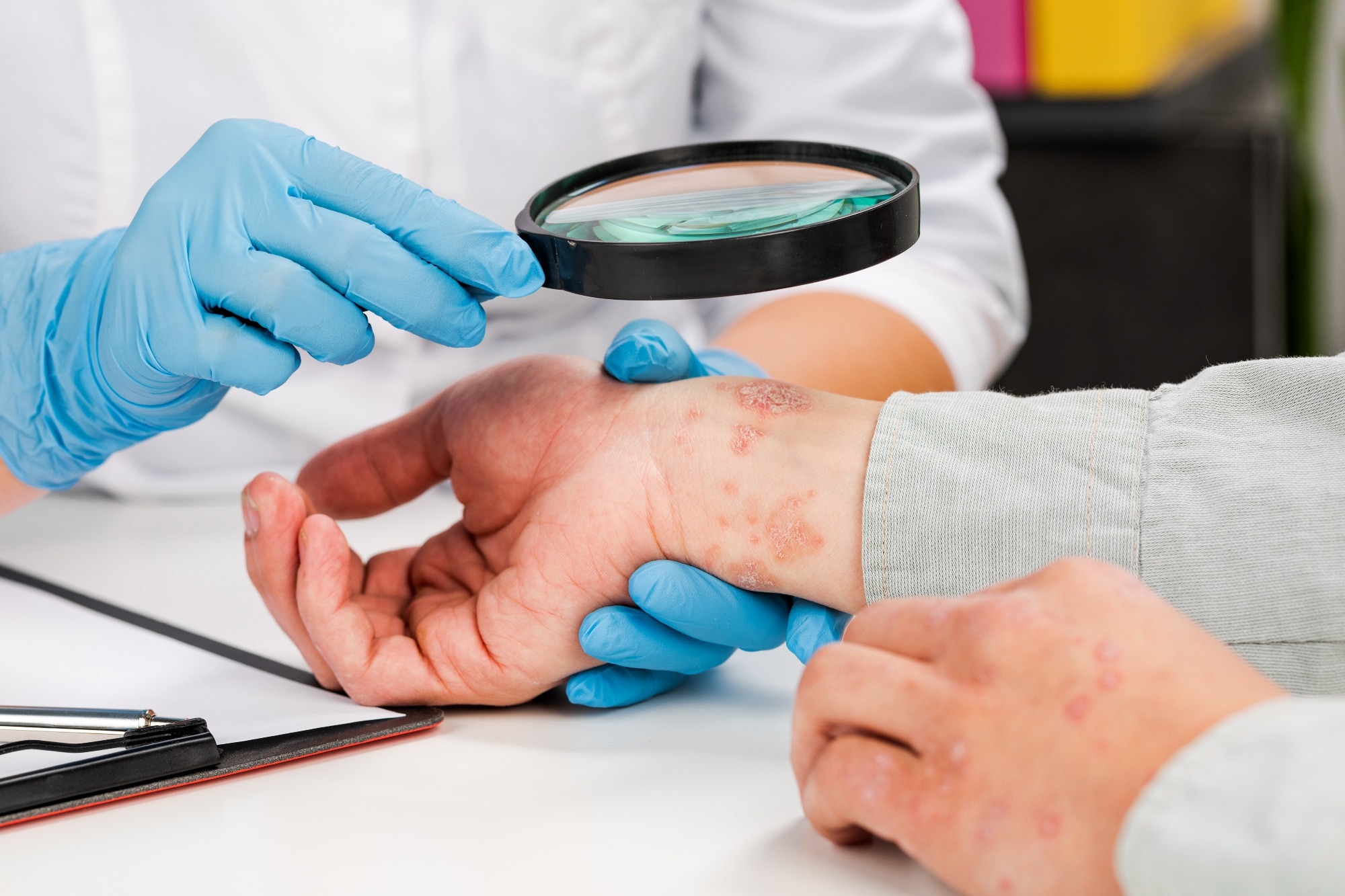Introduction
The extent of incontinence-associated dermatitis
The pathophysiology of incontinence-associated dermatitis
IAD in children
IAD in adults
What is the treatment for incontinence-associated dermatitis?
References
Further reading
Incontinence-associated dermatitis (IAD) is a form of dermatitis caused by irritants that develop from chronic exposure to urine or liquid feces. Incontinence-associated dermatitis (MASD) consists of one of four types of moisture-associated skin damage. Moisture-associated skin damage has been defined as gradual inflammation and skin erosion resulting from prolonged exposure to several sources of moisture, including perspiration, wound exudate, mucus, saliva, urine, or feces.
The remaining etiologies of moisture-associated skin dermatitis include intertriginous dermatitis (caused by perspiration), peri-wound MASD (caused by wound exudate), and peristomal MSD (caused by ostomy output).
Identifying the correct cause and differentiating incontinence-associated dermatitis from other skin conditions is essential to guide prevention and treatment. In addition, evidence-based medicine, which uses explicit and judicious evidence in making decisions about the individual care of patients, is necessary. These comprise a professional's clinical experience, the patient's preference, and the best guidance sourced from the best external advice; these components must be considered when developing a care plan.

Image Credit: Buravleva stock/Shutterstock
The extent of incontinence-associated dermatitis
Irritant-associated dermatitis is an under-reported health care condition. For example, in 2003, an initial sample of 20,000 and 28 American adults with 30 acute and chronic conditions did not report any findings associated with incontinence or its impacts on the skin, such as incontinence-associated dermatitis.
In a recent review, which examined the extent of the phenomenon, the study of a ward examined 272,841 encounters in which incontinence-associated dermatitis was diagnosed. The infant prevalence was estimated to be 7%, with the highest prevalence occurring between nine and 12 months.
The prevalence of incontinence-associated dermatitis in the critically ill further ranges between 7 and 50%, and incontinence-associated dermatitis occurs in half of those patients who suffer from diarrhea in the intensive care unit. Similarly, incontinence of urine, feces, or both, are associated with high levels of incontinence-associated dermatitis; of those with incontinence, 45.7% suffered from incontinence-associated dermatitis.
In long-term and acute care, a study has reported an incidence of 7.6% in a long-term acute care facility in the United States. The reason for this rate of prevalence was attributed to the use of soap, water, and washcloths routinely in the care of persons with incontinence-associated dermatitis.
Despite this, incontinence has been identified as a concern for both patients under caregivers. A European team that surveyed 355 patients determined that urinary incontinence was the most frequent problem encountered in 15.8% of cases. Following this was fecal incontinence (14.6%). Therefore, it is important to consider the voices and opinions of caregivers and patients. However, this is not always reported in the literature.
A notable example of this is in a survey conducted by the AARP, which determined that among the seven categories of possible nursing tasks performed by caregivers, 35% of them comprised ostomy or wound care, for which caregivers found the most difficult to undertake. This difficulty was reported to be familial and social norms, as this form of care requires intimate contact and is hinged upon a long-standing relationship between the family caregiver and the patient.
The pathophysiology of incontinence-associated dermatitis
The skin is comprised of several layers. The stratum corneum is the outer layer of the skin and is composed of keratinized epithelium. The stratum corneum has an acidic pH of 5.6, which biases the synthesis of ceramides by the enzyme β-glucocerebrosidase. Healthy skin provides a protective barrier via lipids and corneocyte cells (referred to as the mortar and brick, respectively); the mechanisms by which incontinence-associated dermatitis disrupts the barrier are attributed to several factors, with the major of them being changes in pH and level of moisture.
The skin microbiota is kept within homeostatic balance when the skin pH remains in the acidic range. When the skin pH moves into the alkaline range, the relative concentrations of pathogenic bacteria increase. Repeated exposure to urine or feces can change the normal acidic pH of between four and six to an alkaline pH of greater than 7. Moreover, using alkaline soap can also increase the skin pH; once it is raised to the alkaline range, the skin's structure is altered, making the skin more vulnerable to damage. This is because enzymes such as alkaline ceramidase have increased activity at alkaline levels. This is particularly true in adult skin, which explains why adult skin is more vulnerable to damage from incontinence.
Another source of damage to the skin can be caused by aggressive cleaning and friction of wet skin. Wet skin also has a higher frictional coefficient than dry skin and is, therefore, more susceptible to damage; wet skin produces the highest skin surface loads in response to compression and force compared to dry skin. Therefore, managing incontinence to prevent excessive wetting of the skin can avoid lesions such as pressure injuries caused by aggressive wiping and cleansing.

Image Credit: Fuss Sergey/Shutterstock
IAD in children
In children, the structure of the stratum corneum is thinner, and the microvasculature is less organized compared to adults. Therefore, there is a lower concentration of melanin compared to adult skin. The infant skin pH levels are also higher than adults ranging from 6.34 to 7.5. As a result, the epidermal barrier is further undeveloped, and in premature children, the problem is further exacerbated.
This is because the stratum corneum of premature babies is only two to three layers thick compared to 10 to 20 layers seen in infants. This puts premature infants at an increased risk of transepidermal water loss and experience increased absorption of substances applied topically. Subsequently, their skin is more susceptible to chemical and mechanical injury.
Factors that predispose this population to increased risk of skin damage, particularly in the diaper region, include exposure to urine and stool, increased pH, overhydration, and diet, along with the depth of the stratum corneum. These cause friction, moisture, and occlusion in the diaper area, which irritates the skin and causes incontinence-associated dermatitis.

 Read Next: What Causes Dermatitis?
Read Next: What Causes Dermatitis?
IAD in adults
As the skin ages, skin function rapidly deteriorates; in older populations, the skin has a higher activity level of the enzyme alkaline ceramidase, which can render the skin structure vulnerable. Skin with deeper wrinkles and aged skin has a higher risk, quantified as six times greater, than younger skin for susceptibility to stress damage. Older skin is also thinner, with a 20% loss in dermal thickness. Other changes that make older skin particularly susceptible to incontinence-associated dermatitis include flattening of the dermal-epidermal junction and increased alkalinity of the skin.
What is the treatment for incontinence-associated dermatitis?
data from clinical trials and studies that focus on the prevention and treatment of incontinence-associated dermatitis have been used to assess the effectiveness of different methods used to prevent it. A study that examined these data found that soap and water are inadequate for the prevention and treatment of the condition. A structured skincare protocol was found instead to significantly reduce the incidence of incontinence-associated dermatitis.
This structured skincare includes the use of a skin cleanser, moisturizer, and skin protectants. It is important that cleansing is performed with a product with a pH near that of normal skin. Moreover, pads worn by patients with a higher absorbent capacity are found to increase the ability to keep the skin dry; In conjunction, polymer-based nappies or underpads are more effective in preventing skin breakdown than non-polymer products.
References
Further Reading